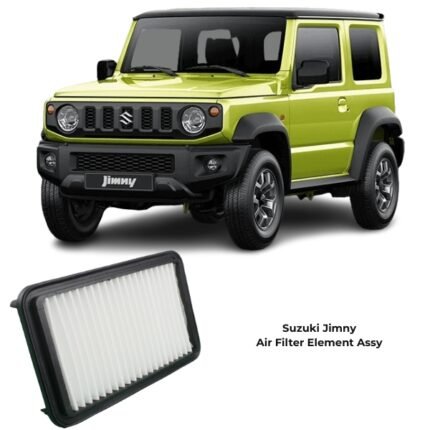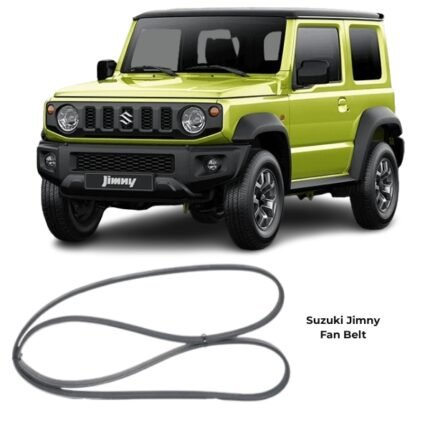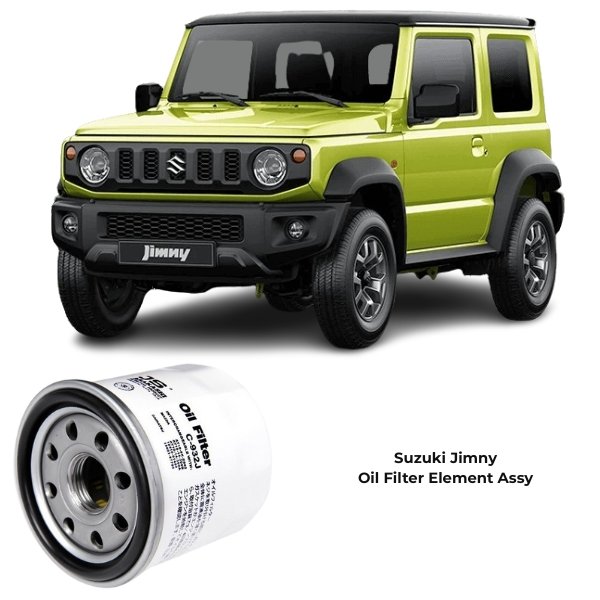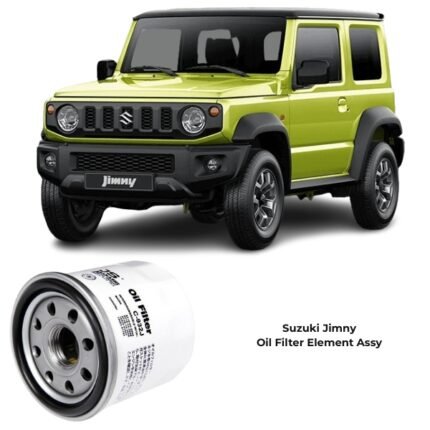Get Suzuki Jimny Oil Filter Element Assy C932J in Kenya
The Oil Filter Element Assembly is a vital component of an internal combustion engine’s lubrication system. It plays a critical role in ensuring the engine oil remains clean, free from impurities, and capable of providing optimal lubrication to all moving parts. While it may appear to be a small and simple device, its function is indispensable in maintaining engine performance, longevity, and efficiency. The oil filter assembly prevents contaminants such as metal particles, carbon deposits, and sludge from circulating through the engine, thereby reducing wear and tear and ensuring smooth operation.
1. Purpose and Function
The primary purpose of the oil filter element assembly is to remove contaminants from the engine oil. During engine operation, oil circulates continuously to lubricate bearings, pistons, crankshafts, camshafts, and other moving parts. However, over time, impurities such as dust, carbon residues, and microscopic metal particles accumulate in the oil. If left unfiltered, these contaminants can cause abrasion and corrosion on engine surfaces, leading to premature wear or even engine failure.
The oil filter assembly ensures that only clean and purified oil reaches the critical engine components. By filtering out contaminants, it maintains proper lubrication, reduces friction, controls temperature, and helps in extending both oil life and engine life.
2. Construction and Components
An oil filter element assembly is designed with precision to handle the high pressures and temperatures of an operating engine. It is composed of several key components, each serving a specific purpose:
-
Filter Element (Media): The core of the assembly, responsible for trapping impurities. Made from pleated cellulose, synthetic fibers, microglass, or a combination of materials. The pleated structure increases surface area for efficient filtration.
-
Filter Canister or Housing: A durable metal or composite casing that holds the filter element securely and withstands oil pressure.
-
Base Plate: Contains inlet and outlet holes that regulate the flow of oil through the filter.
-
Anti-Drain Back Valve: A rubber valve that prevents oil from draining out of the filter when the engine is turned off, ensuring immediate oil supply during the next start.
-
Bypass Valve: Opens when the filter becomes clogged or oil pressure is too high, allowing unfiltered oil to bypass the filter and reach the engine. This prevents oil starvation and engine damage.
-
End Caps: Seal both ends of the filter element and direct oil flow through the filtering media.
-
Sealing Gasket: Ensures a tight seal between the filter and the engine block to prevent leaks.
Each of these parts works together to ensure a steady supply of clean oil, maintaining pressure balance and preventing contamination-related engine problems.
3. Types of Oil Filters
There are different types of oil filter assemblies, designed based on vehicle and engine requirements:
-
Spin-On Oil Filter: The most common type, featuring a built-in housing and filter element. It is replaced as a complete unit during servicing.
-
Cartridge (Element) Oil Filter: Only the filter element is replaced, while the housing remains fixed to the engine. This design is eco-friendly and reduces waste.
-
Magnetic Oil Filter: Includes a magnet to capture metallic particles in addition to traditional filtration.
-
Centrifugal Oil Filter: Uses centrifugal force to separate contaminants from the oil, commonly found in heavy-duty applications.
-
High-Performance Filters: Designed for racing or extreme environments, offering higher flow rates and enhanced filtration capacity.
4. Working Principle
The operation of an oil filter element assembly follows a precise and continuous flow process:
-
Oil Intake: Engine oil from the sump is pumped through the filter’s inlet holes.
-
Filtration Process: The oil passes through the filter media where contaminants are trapped in multiple layers. Larger particles are captured on the surface, while finer particles are trapped deeper within the media fibers.
-
Clean Oil Output: After filtration, purified oil flows through the central tube or outlet port and returns to lubricate engine components.
-
Pressure Regulation: The bypass valve activates only if the filter is clogged or oil is too thick (e.g., during cold starts), ensuring continuous oil flow even under adverse conditions.
-
Oil Retention: When the engine stops, the anti-drain back valve holds oil within the filter, preventing dry starts.
This systematic operation ensures uninterrupted lubrication and consistent engine performance.
5. Importance in Engine Health
The oil filter element assembly plays a vital role in preserving engine health and efficiency:
-
Reduces Wear and Tear: Clean oil forms a protective film between moving parts, preventing direct metal-to-metal contact.
-
Enhances Performance: Proper filtration maintains consistent oil pressure and ensures smooth engine operation.
-
Improves Fuel Efficiency: Clean oil reduces internal friction, improving energy transfer and reducing fuel consumption.
-
Extends Engine Life: By removing abrasive contaminants, the filter minimizes damage and extends the engine’s service lifespan.
-
Prevents Oil Degradation: Filtering out carbon residues and sludge slows down the oxidation and breakdown of engine oil.
Without an effective oil filter, contaminants would circulate freely, drastically shortening the life of both oil and engine components.
6. Signs of a Faulty or Clogged Oil Filter
Like all consumable parts, oil filters have a limited lifespan. When a filter becomes clogged or damaged, the engine may exhibit several warning signs:
-
Oil Pressure Warning Light: Indicates restricted oil flow due to a clogged filter.
-
Dirty or Darkened Oil: Suggests that the filter is no longer effectively cleaning the oil.
-
Metallic Noise from Engine: Caused by poor lubrication from restricted oil flow.
-
Oil Leaks: Can occur if the gasket or filter housing is damaged or improperly installed.
-
Reduced Engine Performance: Resulting from friction and overheating due to contaminated oil.
Ignoring these symptoms can lead to costly repairs or even catastrophic engine failure.
7. Maintenance and Replacement
Proper maintenance of the oil filter element assembly is crucial. It should always be replaced together with the engine oil during routine service. The replacement interval depends on driving conditions and oil type:
-
Conventional Oil: Replace every 5,000–8,000 kilometers.
-
Synthetic Oil: Replace every 10,000–15,000 kilometers.
-
Severe Conditions (Dusty, Stop-and-Go, or Heavy Loads): Replace more frequently.
Steps for Replacement:
-
Drain the old engine oil.
-
Remove the old oil filter using a filter wrench.
-
Check and clean the filter mounting surface.
-
Lubricate the gasket of the new filter with fresh oil.
-
Install the new filter securely but avoid over-tightening.
-
Refill with new engine oil and check for leaks after starting the engine.
Regular replacement ensures the engine receives continuous protection from wear and contamination.
8. Material Innovations and Design Improvements
Modern oil filters are engineered with advanced materials to enhance filtration efficiency and durability. Synthetic microfiber media can capture particles as small as 10 microns while maintaining high flow rates. Some filters use dual-layer or multi-grade media to balance fine filtration with long service intervals. The adoption of eco-friendly cartridge systems reduces waste by allowing only the filter element to be replaced.
Additionally, smart oil filter technologies are emerging—some include built-in sensors that monitor oil quality and flow, providing real-time data to onboard diagnostic systems.
9. Consequences of Neglecting Oil Filter Maintenance
Failing to replace or maintain the oil filter can lead to severe engine damage and reduced performance:
-
Engine Wear and Damage: Contaminants cause abrasion on pistons, bearings, and valves.
-
Reduced Oil Flow: A clogged filter restricts oil circulation, leading to overheating and part seizure.
-
Sludge Formation: Unfiltered particles accumulate, forming sludge that blocks oil passages.
-
Poor Fuel Efficiency: Contaminated oil increases internal friction.
-
Engine Failure: Prolonged neglect can result in complete engine breakdown, requiring costly repairs.
Thus, regular inspection and timely replacement of the oil filter are non-negotiable aspects of engine maintenance.
Follow us on Facebook for more parts.





Reviews
Clear filtersThere are no reviews yet.